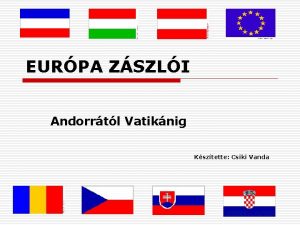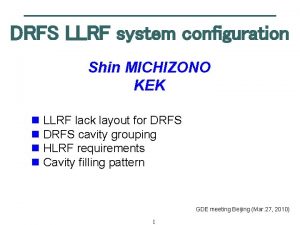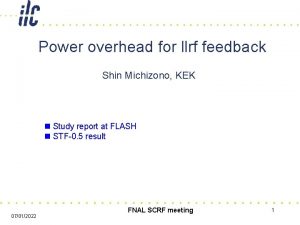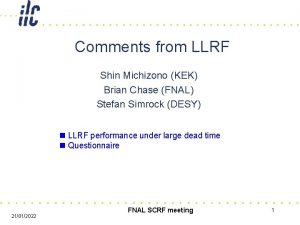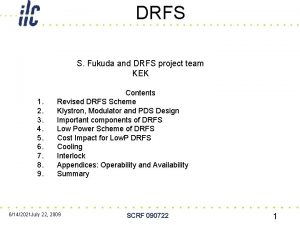LLRF requirementsissues for DRFS Shin MICHIZONO KEK 1





- Slides: 5

LLRF requirements/issues for DRFS Shin MICHIZONO (KEK) 1 BAW 1 (Sep. , 2010)

Outline n Three important requirements concerning LLRF: 1. LLRF feedback overhead (nominal ~15%) 2. Gradient flatness of each cavity for near-quench-limit operation (5%? ) 3. Pulse-to-pulse stability of each cavity for luminosity operation (~1%) n Tolerance of Pk, Ql and detunings to satisfy these requirements are considered. n Cavity control schemes are compared (for DRFS): 1. Pk. Ql control: set rf power ratio and external Q (Qls) so that cavity gradients become flat at specific beam current. 2. Cavity grouping: select same performance cavities and operate at the same gradients. n DRFS will adopt “cavity grouping” because of 1. Elimination of circulators (This requires same gradient operation. ) 2. Saving of rf power (Pk. Ql control requires 14% additional power since the cavity Qls are not matched to beam loading. ) n Some ideas to operate 38 MV/m (at cavity grouping) are also shown. 2 BAW 1 (Sep. , 2010)

Power Overhead n Static rf losses (use the rf overhead at all times) n Klystron HV ripple (1% HV ripple -> 2. 5% rf power) n Ql tolerance n Pk distribution tolerance n Pre-detuning of each cavity (~2% rf power) n Distribution of pre-detunings n Reflection power (in case of the Pk. Ql control, ~14% rf power) n Dynamic rf losses (used by the feedback control) n Klystron HV fluctuation n Beam current fluctuation n Dynamic detuning (microphonics+ Lorentz force detuning) These issues will be covered by the llrf overhead. If the overhead is not enough the regulation of the rf fields will not satisfy the requirements 3 BAW 1 (Sep. , 2010)

LLRF control at DRFS n Pk. Ql control: additional 14% rf power is required when 2 cavity operation with 25 MV/m and 38 MV/m. Need circulators and variable Ql, Pk. n Cavity grouping: no additional power is required. But need to examine the driving of cavities at 38 MV/m. -> We will adopt cavity grouping and propose some ideas to drive 38 MV/m cavities at small overhead. 4 BAW 1 (Sep. , 2010)

Simulation results RDR DRFS (Pk. Ql) DRFS(Cavity grouping) Operation gradient Max. 33 MV/m Average 31. 5 MV/m Max. 38 MV/m RF source 10 MW Waveguide loss 8% power 2% power Static loss (Ql, Pk) 2% power 2. 5% power Microphonics 2% power Reflection 0% power 14% power 0% power Other LLRF margin 10% power 5%~10% power Ql tolerance 3% (2) Pk tolerance 0. 2 d. B (2) 15 Hz rms(3) 20 Hz rms (3) RF power Kly Hv ripple Tolerance Detuning tolerance Beam current offset 800 k. W 2% rms (3) (1) LLRF overhead ~5% (2) Cavity gradient tilt (repetitive) ~5% (3) Pulse-to-pulse gradient fluctuation ~1%rms n We have to examine these numbers experimentally. n Tolerance should be discussed with cavity and HLRF group. If the tolerance is smaller, better gradient tilt would be possible. 5 BAW 1 (Sep. , 2010)
